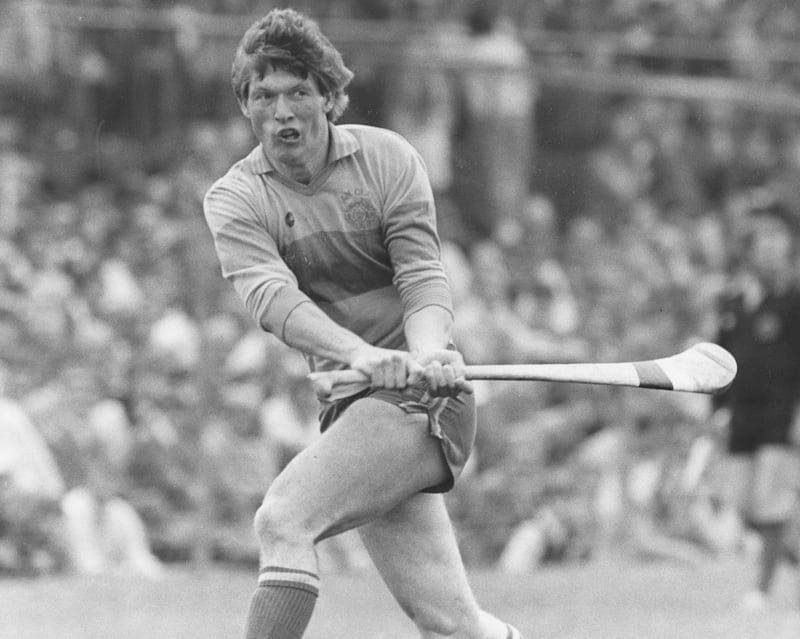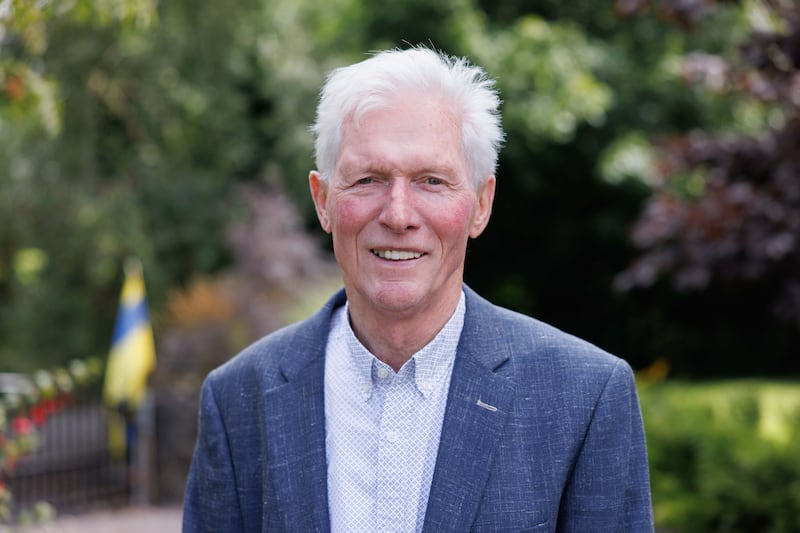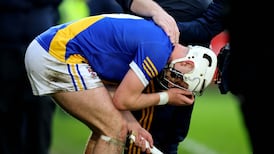His achievements are all around. The family business, Conor Engineering, which he took over nearly 40 years ago, stands just a short walk away from Enda O’Connor’s house in Tubber – an incongruous beacon of industry in rural Clare.
On the walls of his and Carmel’s lovely home are mementoes of another time when he was an essential member of a team, etched into posterity as the ultimate hard-luck story. He and his brothers played for Clare and also backboned the only Tubber team to reach a senior county final.
He has national league medals from 1977 and ‘78 when Clare defeated Kilkenny but in tightly contested Munster finals, couldn’t get past the top team of the age, Cork’s three-in-a-row All-Ireland winners of 1976-78.
The irony of the county’s modern successes is that Liam MacCarthy has twice been lifted regardless of failure to win Munster, the province which effectively imprisoned the team of the 1970s – and in both 2013 and this year, they defeated their ancient tormentors Cork on the climactic day of the season.
READ MORE
In August, just after this year’s All-Ireland final, the saffron and blue flags fly all around Tubber until they give way to the maroon and white of Galway – Gort is just down the road.
In July he sat down to watch the All-Ireland and didn’t take in a minute of it, becoming restless as his attention wandered. Enda O’Connor at 70 has been battling Alzheimer’s and isn’t winning.

When they were kings – nearly
According to the O’Connors, Fr Harry is still giving out about the sending-off of Jim Power in the 1977 Munster final just before half-time. It was the incident on which the contest pivoted.
Clare had arisen from their diffident history and beaten Kilkenny in that April’s league final. They were so well supported in that year’s Munster final that a Thurles match steward remarked to Paddy Downey in The Irish Times: “If anything happens in Clare, there will be nobody there to see it.”
Having fallen behind to an early penalty, it was Enda O’Connor who riposted with Clare’s first goal. On the weekend of this year’s All-Ireland his daughter, Suzanne, WhatsApped an old YouTube clip of her father’s score. Within a couple of hours, it had come back to her, marked ‘forwarded many times’.
Fr Harry Bohan is at least as well known as a sociologist, rural economist and community activist as the man who managed the 1970s Clare team but those travails of nearly 50 years ago still sting.
“That year, 1977, was the year we could have won the All-Ireland.”
He is also a friend of the O’Connor family.
“The few make things happen; the many watch things happen and the majority don’t know what’s happening! I always thought Enda and the O’Connor family belong to the few who made things happen.
“They created up to 40, 50 jobs at times. Jamie died young but when Enda took over 40 years ago with Carmel his wife, it grew into a significant, exporting engineering business. Another brother Pat is a substantial farmer.
“Coinciding with this enterprise, Enda, Mike and Pat were on a Clare team that I managed in the 1970s. That team would be given credit for breathing confidence into Clare hurling in the belief that if Cork, Kilkenny and Tipp could win All-Irelands, why couldn’t Clare?
“The O’Connors were very comfortable with, and at the heart of, that attitude. From a hurling point of view, Enda was a man with huge hurling skill and he feared no one. What I mean by that is that he never looked up to fellas in that sense; he took them on. He was his own man.
“His approach as a top-class forward – and this was in the days before helmets – was out to the ball, put down the head and go for goal. That’s the way I will always remember Enda O’Connor on the field.”
In a hurry
John Callinan is a team-mate and friend from the 1970s and ‘80s. He, Séamus Durack and Barry Smith have kept in touch with Enda. Callinan remembers the impact of the O’Connor’s business and the optimism it created even within the team.
“I was living in Clarecastle at the time and Enda would pick me up; because of the success of his family business, he always had the best of cars. I remember he had a three-litre Capri one time – Jeez, it would nearly take off.
“You would immediately be attracted to Enda – he always had a smile on his face and he was never down about anything. We became great friends. He supplied a car for my wedding in 1978 and I have these photographs of a beautiful blue Mercedes – I had a 10-year-old Escort at the time.
“His family business in north Clare was emblematic of a breakthrough in industry for the area. I’m not saying we were thinking too deeply about that but it gave an aura of success, which fed into our confidence – that the O’Connors had done this in as unlikely a place as Tubber.”
There was a determined optimism about him, a refusal to be derailed by setbacks, Harry Bohan remembers.
“He was always, no matter how disappointing the defeat, looking forward in the dressingroom: ‘we’ve a match next week’.”
After the 1977 league final, Enda O’Connor was called up as a replacement for that year’s All Stars tour to the US, which was leaving in a week. He had to scramble fast to organise a visa but there was no stopping him – in general.

Making things happen
In a short 1978 RTÉ documentary presented by Doireann Ní Bhriain on that year’s Munster final, she talks after the match to Harry Bohan and Ger Loughnane, who would 17 years later deliver the All-Ireland to Clare. Both agree that the 1970s team is by no means finished but effectively, after another narrow defeat, 0-11 to 13, it was.
Tubber, however, would have their best season in senior hurling in 1981, reaching the county final but losing to Newmarket-on-Fergus.
“He was manager, trainer, captain and they got to the county final,” remembers his wife, Carmel.
“He had a child being born as well that year,” remembers the child in question, daughter Suzanne.
Her brother Barry, who is now director of the family business and who also hurled, remembers: “He played junior until his early 40s. He did everything in the club: chaired it, raised funds for floodlights, was manager on several occasions. We won senior B in 2003 and he was manager.”
There was even a trip to Royal Ascot in 2007 for the Queen Mary Stakes. Enda was involved in a syndicate, which owned a horse called Elletelle and he and Carmel hit the racecourse, top hat, finery and all.
“Johnny Murtagh [the jockey] suggested bringing it to Ascot,” says Carmel. “Lo and behold, didn’t it win. ‘The best day of my life,’ according to Enda!”
Elletelle came home at 20-1 but had been available at 33-1 ante-post. Suzanne was forced to watch from a distance.
“I had a sick child and couldn’t travel. I watched it in a bookies in Gort – I was told never to come back!”
In the foundation story of the team of the 90s, the two years preceding 1995 are a prelude. Ger Loughnane, who took over as manager, had been a selector with predecessor, Tipperary All-Ireland winner Len Gaynor. The other selectors were Fr Willie Walsh, about to be appointed Bishop of Killaloe, and Enda O’Connor.
They gave call-ups to many players with a big future, including this year’s All-Ireland winning manager, Brian Lohan.

The sadness
Carmel O’Connor shows the pictures of her husband’s old teams and the framed display of his medals. On an August afternoon she and Enda, Barry and Suzanne – both of whom work in the family business – are welcoming despite the intrusion.
There are two other children not present, James and Darragh, who has recently started working for the family business.
Enda is in remarkably good physical shape. He talks away at times and references things like the impressive lining of trees around the house, which he planted.
All families familiar with the scourge of dementia know the moments when the sufferer falls silent and they in futile deference, lower their voices to talk about him or her, the borderline between resigned, bleak humour and sheer weariness.
Ten years ago, Enda began to experience memory loss and it deteriorated into a diagnosis of Alzheimer’s.
Eamon Ward, the photographer arrives. He knows the family from a publicity shoot at the factory where a vast tanker was being launched for export to New Zealand.
“That particular one,” says Barry, “was going to a farm with something like 3,000 cows so a massive amount of slurry has to be moved. He actually bought two of them.”
Carmel, who is retiring from the business, talks about how Enda would often take the short walk down to the engineering works.
“He gradually phased out his involvement but would still work down there until very recently, doing various menial tasks. Up to the beginning of this year he would go down every day but that’s faded now, too.
“He was a doer. You know when you have your own business. He was stuck in everything, very involved in the local gun club and was gone every Sunday with the two dogs. He had a lot going on. There were properties in Ennis he developed commercially. He did a lot in his time while he was able.
“Now he’s not physically capable. It’s awful. He’s not able to do anything. He can’t watch television. He can’t read a paper. He can’t work. He can’t walk the dogs, nothing. It’s hard trying to keep him occupied . . . What can you do?”
The Alzheimer Society provides occasional but blessed relief with a carer to keep an eye on Enda, which allows Carmel a bit of respite for lunch with someone or some other diversion.
Enda sits there, surrounded by the trappings of his world, a lovely home, his achievements preserved in picture frames on its walls, a devoted family just a couple of minutes from the business, which through acumen and hard work was built up through the decades.
Sadly, it’s a world he inhabits but can no longer access.
– The Alzheimer Society of Ireland holds its national fund raiser, the Memory Walk, on Sunday, September 22nd. It takes place in many locations, including Ennis. For further details, see alzheimer.ie/get-involved/fundraising-events/alzheimer-memory-walk/
- Sign up for push alerts and have the best news, analysis and comment delivered directly to your phone
- Join The Irish Times on WhatsApp and stay up to date
- Listen to our Inside Politics podcast for the best political chat and analysis














